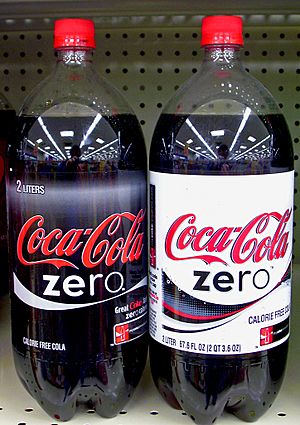Two-liter bottle facts for kids
A two-liter bottle is a very common container. You often see it holding soft drinks, but it can also hold beer or wine. These bottles are usually made from a type of plastic called PET plastic. Sometimes they are made from glass. They are shaped using a process called blow molding.
The labels on these bottles are plastic sleeves that fit tightly. They have a screw-on cap that you can close again. This helps keep the drink fresh and fizzy after you open it.
In the United States, the two-liter bottle is special. It's one of the few products sold using a round number of metric units. Because not many other drinks come in this exact size, when people say "two-liter" in America, they almost always mean a soft drink bottle. Other common plastic soft drink bottle sizes include 500 milliliters, 1 liter, and 3 liters.
Contents
How the Two-Liter Bottle Started
When Was the Two-Liter Bottle Invented?
PepsiCo first introduced the two-liter soft drink bottle in 1970. This idea came from market research led by John Sculley. He later became famous for leading Apple Inc. from 1983 to 1993.
The bottle's design and how it was made came from a team at DuPont. This team was led by Nathaniel Wyeth. He received the patent for the bottle in 1973. Later, in 1985, a three-liter bottle also appeared in stores. Some companies still use that design today.
What Are Two-Liter Bottles Made Of?
Most modern two-liter bottles are made from one piece of PET plastic. The bottom of the bottle is molded with special ridges. These ridges make the bottom strong and help the bottle stand up straight.
Older two-liter bottles were a bit different. They had a separate, solid base that was glued to the clear plastic bottle. This base also had ridges and small holes to let water drain.
Giving Bottles a New Life
How Are Two-Liter Bottles Recycled?
Used two-liter bottles can be recycled and turned into many new things. They can become carpeting, parts of boat hulls, or polyester fabric. The material can also be used as filling for jackets, sleeping bags, mattresses, and pillows.
Sometimes, they are made into new recycling bins. They can even be used to create artificial floating islands or scouring pads. More and more, old two-liter bottles are being turned into brand new soft drink bottles.
Bottle Measurements
What Are the Typical Dimensions of a Two-Liter Bottle?
Here are the usual sizes for a two-liter bottle:
- Height: About 300 to 330 mm (12 to 13 in) (that's around 12 to 13 inches)
- Diameter: About 120 to 100 mm (4.7 to 3.9 in) (that's around 4 to 5 inches across)


